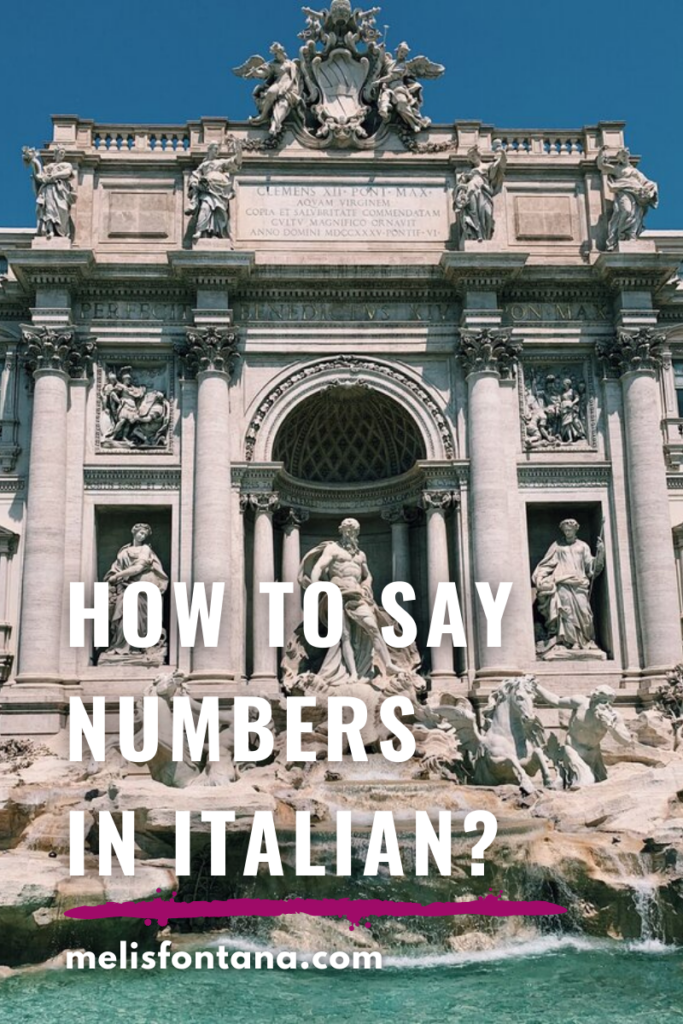
In this lesson, you will learn numbers in Italian and how to pronounce the numbers in Italian.
Numbers in Italian: Numbers from 0 to 20
There is no rule for numbers between 0 and 10 in Italian. Even if the numbers between 10 and 20 follow a rule, there are some changes in the pronunciations as the numbers come together. If you learn the numbers between 0 and 20 and then the multiples of 10, you can compose other numbers without having to memorize them.
Let’s learn the numbers between 0 and 20 in the table below.
| 0 | zero | ||
| 1 | uno | 11 | undici |
| 2 | due | 12 | dodici |
| 3 | tre | 13 | tredici |
| 4 | quattro | 14 | quattordici |
| 5 | cinque | 15 | quindici |
| 6 | sei | 16 | sedici |
| 7 | sette | 17 | diciasette |
| 8 | otto | 18 | diciotto |
| 9 | nove | 19 | diciannove |
| 10 | dieci | 20 | venti |
Numbers in Italian: Numbers from 20 to 100
First, let’s see the numbers that are a multiple of 10.
| 10 | dieci | 60 | sessanta |
| 20 | venti | 70 | settanta |
| 30 | trenta | 80 | ottanta |
| 40 | quaranta | 90 | novanta |
| 50 | cinquanta | 100 | cento |
When you want to add another number next to these numbers, which are multiples of 10, do as following; Let’s say you want to say 25, then you just need to put “venti” meaning 20 first and “cinque” meaning 5 and say venticinque.
44 = quaranta + quattro = quarantaquattro
67 = sessanta + sette = sessantasette
- If the first number ends with a vowel and the number next to it begins with a vowel, the vowel at the end of the first number omits. For example;
31 = trenta + uno = trantuno
28 = venti + otto = ventotto
Numbers in Italian: Over 100
| 100 | cento |
| 1000 | mille |
| 1.000.000 | millione |
| 1.000.000.000 | miliardo |
- To create numbers with 100, it is enough to say all the numbers in order just like in English.
200 = due + cento = duecento
257 = duecento + cinquanta + sette = duecentocinquantasette
1179 = mille + cento + settanta + nove = millecentosettantanove
- 1000 is mille, but when you say multiples of 1000 (2000, 3000 etc.), mille becomes mila.
2000 = duemila
5000 = cinquemila
2179 = duemila + cento + settanta + nove = duemilacentosettantanove
Ordinal Numbers: 1 to 10
Ordinal numbers between 1 and 10 are irregular.
| first | primo | sixth | sesto |
| second | secondo | seventh | settimo |
| third | terzo | eighth | ottavo |
| fourth | quarto | ninth | nono |
| fifth | quinto | tenth | decimo |
Ordinal numbers are formed by adding the suffix -esimo to the end of all numbers after 10 and dropping the vowel at the end of the number.
Twentieth = venti + essimo = ventessimo
Eleventh = undici + essimo = undicessimo
Thousandth = mille + essimo = millessimo
You can find other articles about learning Italian here.
Check here for tips and tactics on other languages!
Good luck!
